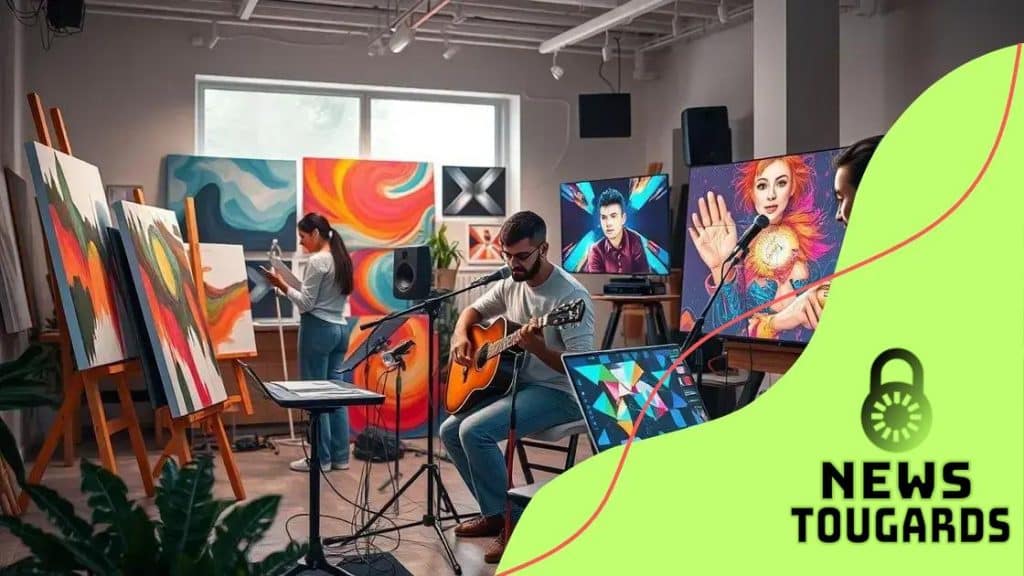The role of AI in transforming the creative industries

The role of AI in transforming the creative industries enhances creativity through innovative tools, while raising important ethical questions about ownership, job displacement, and the necessity of human emotional depth in art.
The role of AI in transforming the creative industries is nothing short of fascinating. From music to visual arts, AI technologies are pushing boundaries, sparking new ideas, and inviting us to rethink creativity itself. Curious about how this affects your favorite art forms?
Enhancing creativity through AI tools
Artificial Intelligence is changing how we think about creativity. With advanced tools, artists can now push their boundaries further than ever before. AI helps in creating new ideas, allowing for more freedom and exploration in the creative process.
Understanding AI Tools
AI tools can enhance creativity by providing unique insights and suggestions. Artists can use these tools to generate different styles, colors, and techniques that they may not have considered before.
Benefits of Using AI
- Inspiration: AI can generate ideas based on existing works.
- Efficiency: Tools can automate repetitive tasks, allowing artists to focus on creativity.
- Collaboration: AI can work alongside creators to brainstorm or develop concepts.
Moreover, AI tools are designed to learn from the artist’s style. This means that as artists work with these tools, they become more tailored to personal preferences. It feels like having a creative partner who understands your vision and helps you expand it.
As different art forms evolve, the role of AI becomes even more significant. For instance, musicians can use AI to compose melodies, suggesting new trends in sound. Visual artists might explore unique patterns or textures, guided by AI suggestions for their pieces.
Real-World Examples
There are numerous examples of artists successfully using AI tools in their work. Some musicians like Taryn Southern incorporate AI-generated compositions into their music, blending human emotion with machine-generated creativity. In painting, artists like Refik Anadol rely on AI to create stunning visual installations that respond to audience interaction.
This intersection between technology and art offers endless possibilities. By embracing AI, artists can expand their creative horizons, discovering new techniques and ideas that can bring their work to life in unexpected ways.
AI’s impact on traditional art forms
AI’s impact on traditional art forms has been transformative, bringing new techniques and insights to artists around the world. Many artists are now exploring how AI can influence their work, enhancing their creativity while respecting classic methods.
Integration of AI and Traditional Techniques
AI technology allows traditional artists to blend their skills with modern advancements. For example, painters can use AI to enhance their color palettes or explore new textures. This combination offers a unique perspective, blending a human touch with machine-generated ideas.
Examples of AI in Traditional Art
- Digital Canvas: Artists can create pieces on digital platforms that incorporate AI suggestions.
- Style Transfer: AI can apply the styles of famous artists to new artworks, creating original pieces that pay homage.
- Generative Art: Tools can produce entirely new works based on algorithms, offering fresh takes on traditional forms.
Furthermore, AI’s analytical capabilities allow artists to examine their works critically. By analyzing patterns and styles, artists can gain insight into their creative processes. This feedback can lead to improved techniques and new directions in their works.
As AI continues to evolve, its impact on traditional art will likely deepen. Artists may find inventive ways to merge their classical approaches with the speed and efficiency of AI. The result is a dynamic interplay between tradition and innovation that shapes the future of artistic expression.
Ultimately, the relationship between AI and traditional art is not one of replacement but collaboration. As artists leverage AI tools, they can explore creativity on levels previously thought unreachable, ensuring that traditional forms thrive in a modern landscape.
How AI is revolutionizing the music industry

AI is revolutionizing the music industry in profound ways, changing how music is created, produced, and consumed. Artists are utilizing AI tools to not only enhance their creativity but also streamline the music production process.
AI in Music Creation
Musicians are exploring new frontiers with AI software that generates melodies, harmonies, and beats. This allows for collaboration between human creativity and machine learning. For instance, AI can analyze existing songs and generate new compositions based on prevailing trends.
Benefits of AI in Music Production
- Efficiency: AI can automate mundane tasks, letting producers focus on creativity.
- Personalization: Algorithms can create music tailored to listener preferences.
- Collaboration: AI can suggest improvements or modifications to existing tracks.
Additionally, AI can help in identifying musical patterns and trends. By analyzing vast databases of songs, AI can track what resonates with audiences. This information is valuable for artists aiming to connect with their fans.
The impact of AI extends beyond creation. It also influences how music is distributed. Streaming platforms use AI algorithms to personalize playlists and recommend songs, enhancing user experience. Listeners can discover new artists through AI-driven suggestions based on their listening habits.
Examples of AI in Music
Several artists and companies are successfully integrating AI into their creative processes. In 2016, the band YACHT used AI to help create their album, reflecting how musicians can now incorporate technology in innovative ways. Similarly, platforms like Amper Music and AIVA allow users to compose music effortlessly with AI assistance.
As AI continues to evolve, its role in the music industry will grow. The collaboration between AI and artists will likely produce never-before-seen forms of music, reshaping our understanding of creativity.
The future of storytelling with AI
The future of storytelling with AI is incredibly promising, as technology continues to empower creators in novel ways. Writers, filmmakers, and game developers are increasingly using AI tools to enhance their narratives, making stories more interactive and engaging.
AI-Driven Narrative Creation
AI can analyze vast amounts of data to help creators craft compelling stories. By examining patterns in successful narratives, AI can suggest plot twists, character arcs, and even dialogue that resonates with audiences. This allows storytellers to focus on creativity while AI manages the structural elements.
Enhanced Immersion Through Personalization
- Interactive Storytelling: AI can adapt narratives based on user choices, leading to unique experiences for each person.
- Character Development: AI can create dynamic characters that evolve based on interactions.
- Real-Time Feedback: AI can analyze audience reactions and adapt the story accordingly.
Furthermore, AI-rich media transforms storytelling into a more immersive experience. Virtual and augmented reality applications allow users to step into the story, making choices that directly impact the outcome. This level of engagement fosters a deeper emotional connection to the narrative.
The integration of AI in storytelling is already evident in popular media. For instance, AI-assisted writing tools are becoming staples in the screenwriting process, helping to refine scripts. Similarly, video games now employ AI to create intricate narratives where player decisions shape the game world.
The Role of AI in Future Content Creation
As technology evolves, the collaboration between human creativity and AI will deepen. The lines between author and AI may blur, leading to innovative storytelling techniques not yet imagined. This partnership could transform not only how stories are told but also who gets to tell them.
In this exciting landscape, the potential for new forms of expression is limitless. With AI as an ally, storytellers can unlock new dimensions in creativity, offering audiences fresh narratives that reflect both the human experience and the capabilities of technology.
Challenges and ethical considerations in AI creativity
Challenges and ethical considerations in AI creativity are becoming increasingly relevant as technology advances. As AI tools become integrated into creative processes, questions arise about originality, ownership, and the implications of machine-generated content.
Understanding Ownership
One major challenge involves determining who owns the creative work produced by AI. When an artwork or music piece is generated by an AI tool, is it the artist, the programmer, or the AI itself that holds the rights? These questions complicate the legal landscape of creativity.
Impact on Employment
- Job Displacement: As AI tools become more capable, there are concerns about job losses in creative industries.
- Shift in Skills: Artists may need to adapt by learning to work alongside AI rather than relying solely on traditional skills.
- New Opportunities: While some jobs may disappear, others will emerge that focus on the collaboration between humans and AI.
Moreover, the use of AI in creative fields can also raise ethical concerns. For instance, the potential for biased representation in AI-generated works can affect public perception and cultural narratives. AI systems learn from data sets, which may include biases that unintentionally carry over into the creative output.
Additionally, the transparent use of AI in art and storytelling is crucial. Artists must be clear about how AI contributes to their work, fostering accountability within creative communities. Audiences have the right to know when they engage with AI-generated content versus human-created content.
Preserving Human Touch
Despite the advantages of AI, maintaining a human touch in creativity is essential. The emotional and experiential aspects of art come from human experience, something that AI cannot fully replicate. Therefore, it’s vital to ensure that human creativity remains at the forefront of the artistic process, with AI serving as a tool rather than a replacement.
Ultimately, navigating these challenges requires collaboration between technologists, artists, and ethicists. Ongoing discussions about the role of AI in creativity will shape future practices, ensuring that technological advancements enhance, rather than diminish, the human experience of art.
The integration of AI into creative industries presents both exciting opportunities and important challenges. As AI tools continue to evolve, they enhance creativity while prompting discussions about ethics and ownership. It is essential to balance technological advancements with the human touch that gives art its emotional depth. Working together, artists and technologists can navigate these complexities to ensure a future where creativity thrives in harmony with innovation.
FAQ – Frequently Asked Questions about AI in Creative Industries
How is AI changing the creative process?
AI is enhancing creativity by providing tools that suggest ideas, automate tasks, and analyze trends, allowing artists to focus more on their art.
What are the ethical concerns regarding AI in creativity?
Concerns include issues of ownership, potential job displacement, and the risk of bias in AI-generated content affecting cultural narratives.
Can AI generate original artwork?
Yes, AI can create original pieces by analyzing existing works and generating new ideas, but the question of authorship remains complex.
What role does the human touch play in AI-generated art?
The human touch is essential for adding emotional depth and personal experiences to art, ensuring that AI complements rather than replaces creativity.





